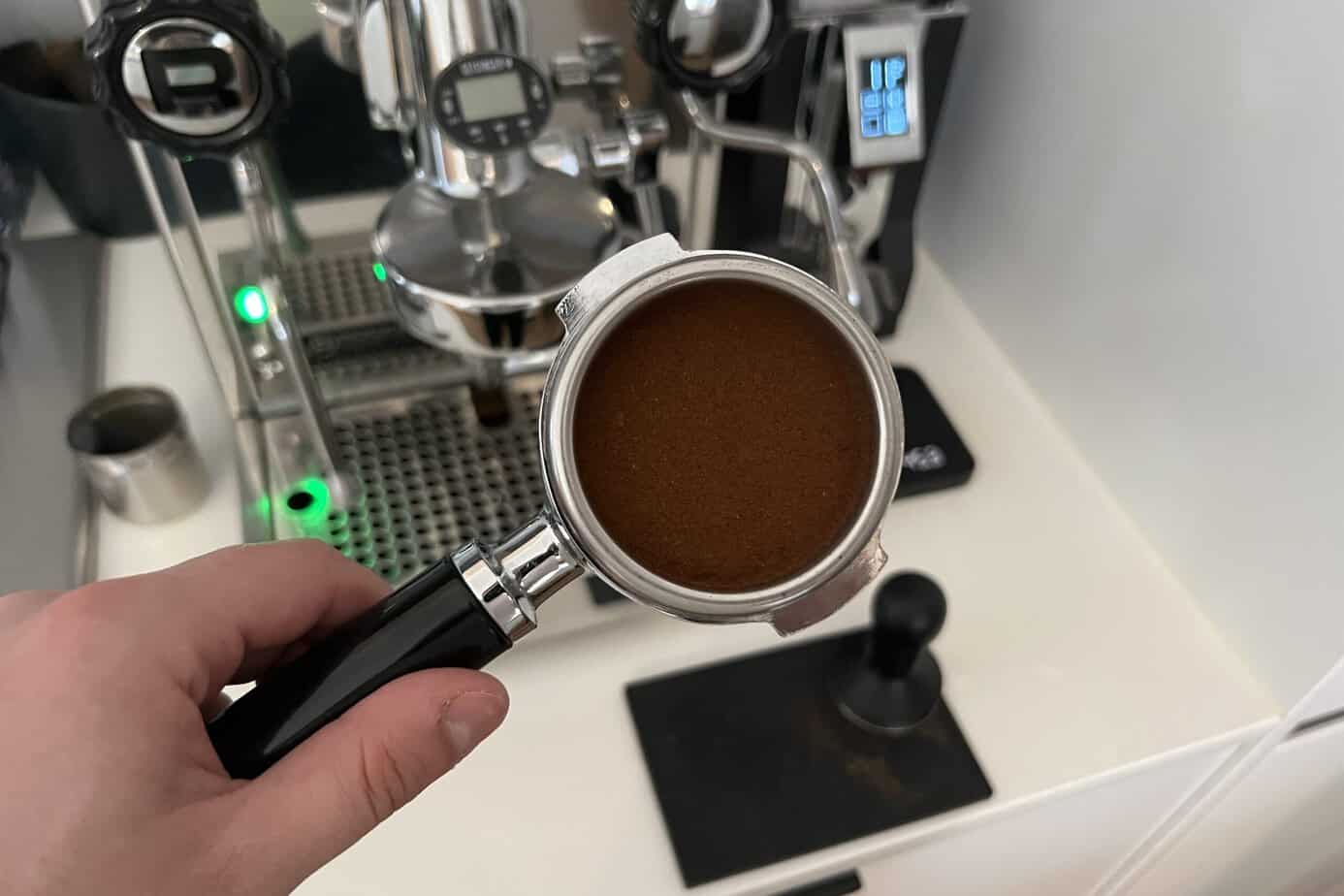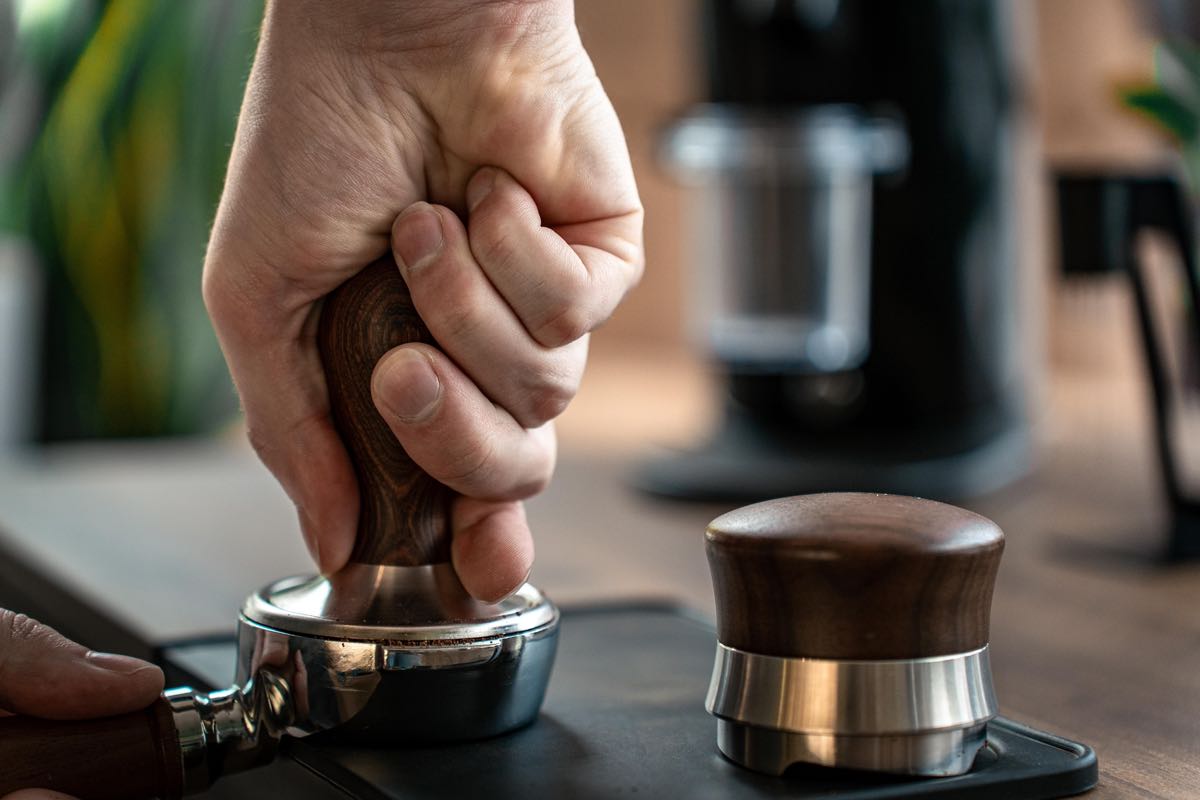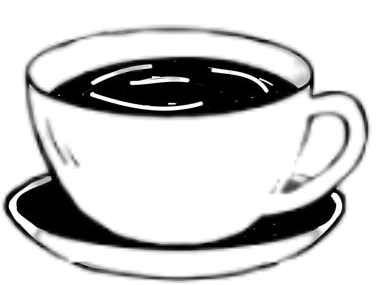Crafting the perfect espresso at home is both an art and a science. It’s a journey filled with trial, error, and, ultimately, satisfaction when you sip that flawless cup. One of the most debated techniques in home espresso-making is tamping. How hard should you tamp when making espresso at home? Let’s dive into this topic from my personal experience and explore what works best. Learn everything about this innovative coffee machine in our DeLonghi Eletta Explore Espresso Machine with Cold Brew review
Understanding the Role of Tamping in Espresso
Before I began making espresso at home, I thought tamping was just a quick press of the coffee grounds into the portafilter. It wasn’t until I started experimenting that I realized its importance. Tamping serves to create an even and compact bed of coffee grounds. This ensures that water flows through evenly during extraction, preventing under-extraction (weak, sour espresso) or over-extraction (bitter, overly strong espresso). Dive into the features and performance in our DeLonghi Dinamica Automatic Coffee & Espresso Machine review

How Hard Should You Tamp When Making Espresso at Home?
The first time I tamped, I used all my strength, thinking that a harder tamp would yield a richer espresso. Spoiler alert: it didn’t. Through research and practice, I learned that the pressure of the tamp isn’t the only factor—it’s about consistency. Ideally, you should tamp with around 20-30 pounds of pressure. But don’t stress about measuring your force precisely. Instead, focus on ensuring that your tamp is level and uniform every time. Explore the versatility of this model in our DeLonghi Magnifica Evo Espresso Machine with Frother review
Why Consistency Matters More Than Pressure
From my trials, I discovered that consistency in tamping pressure was more important than hitting a specific number. Even if you tamp lightly but do so consistently, you’ll likely have better results than varying your pressure wildly. When I focused on tamping evenly and keeping the surface level, my espresso shots became more balanced, with a rich crema and robust flavor.
Tools That Help You Tamp Perfectly
When I first started, I used the tamper that came with my espresso machine. While it worked, it wasn’t ideal. Upgrading to a heavier, ergonomic tamper made a significant difference in my results. Some tools I recommend considering include:
- Weighted Tampers: These help achieve consistent pressure without needing to rely on guesswork.
- Tamper Mats or Stands: These provide stability while tamping, ensuring a level press.
- Calibrated Tampers: These are designed to "click" when the correct amount of pressure is applied.
Using these tools has made my tamping process not only easier but more enjoyable. It’s like having a little helper guiding you toward the perfect espresso. Discover the benefits and features of this machine in our DeLonghi Magnifica Evo review
How Hard Should You Tamp When Using Different Espresso Machines?
Another lesson I learned is that the ideal tamping pressure can vary depending on the espresso machine you’re using. For instance:
- Manual Machines: These often benefit from a firmer tamp because they rely on consistent pressure to extract evenly.
- Semi-Automatic Machines: With these machines, I found that medium pressure worked best. Too firm, and the water struggled to flow; too light, and the shot tasted weak.
- Super-Automatic Machines: These often require minimal to no tamping since they handle the process internally.
Adapting your tamping pressure to your machine can make all the difference in achieving a perfect espresso shot.
The Impact of Grind Size on Tamping
During my espresso-making journey, I realized that tamping pressure isn’t the only variable to consider. Grind size plays a massive role in how hard you should tamp when making espresso at home. A finer grind typically needs lighter tamping pressure to avoid over-extraction. On the other hand, a coarser grind may require a firmer tamp to create adequate resistance. Find out why this model stands out in our DeLonghi Magnifica S review
When I first experimented with grind size, I found myself adjusting my tamping technique accordingly. For example:
- Fine Grind: Gentle and consistent tamping works best.
- Medium Grind: Moderate pressure yields the best results.
- Coarse Grind: A firmer tamp may be necessary to compensate for the larger coffee particles.
Matching grind size with the appropriate tamping pressure has significantly improved the consistency of my espresso shots.
My Step-by-Step Tamping Technique
To simplify the process, I developed a step-by-step tamping routine that works well for me:
- Distribute the Grounds: Before tamping, I use a distribution tool or gently tap the portafilter to ensure even distribution.
- Place the Tamper: Position it flat on top of the grounds.
- Apply Consistent Pressure: Press down with steady, even pressure. I aim for about 20-30 pounds but focus more on maintaining consistency.
- Twist Slightly: A small twist at the end of the tamp ensures a polished surface.
- Check the Level: I always inspect the surface to ensure it’s level before brewing.
This method has become second nature to me and yields reliable results every time.
How Tamping Affects Espresso Flavor
I’ve noticed that the way I tamp directly impacts the taste of my espresso. When I tamp too lightly, the shot tends to be watery and sour. Over-tamping, on the other hand, results in bitterness and a slow extraction time. Finding the right balance—consistent, even pressure—has given me the best flavor outcomes.
How Practice Makes Perfect
Perfecting tamping is not something that happens overnight. It took me weeks of trial and error to feel confident. Initially, I measured my tamping pressure using a bathroom scale to get a sense of 20-30 pounds of force. Over time, my hands developed muscle memory, and I no longer needed the scale.
For anyone wondering how hard to tamp when making espresso at home, my advice is simple: practice. The more you do it, the more natural it becomes, and the better your results will be.
Common Tamping Mistakes to Avoid
Here are a few mistakes I made early on and how I corrected them:
- Uneven Tamping: This causes water to flow unevenly through the grounds. I corrected this by focusing on keeping my tamper level.
- Over-Tamping: This led to bitter espresso and frustrated mornings. Now, I tamp firmly but avoid excessive force.
- Ignoring Distribution: Uneven grounds before tamping caused weak spots. Using a distribution tool solved this issue for me.
The Joy of Mastering Tamping
Looking back at my journey, learning how hard to tamp when making espresso at home has been incredibly rewarding. Each cup is a reflection of my effort and experimentation. The joy of sipping a perfectly brewed espresso made by my hands is unmatched.

Final Thoughts: How Hard Should You Tamp When Making Espresso at Home?
Tamping is a critical step in the espresso-making process, but it doesn’t have to be intimidating. In my experience, the key is to focus on consistency, level tamping, and adapting to your specific equipment and grind size. Whether you’re a beginner or a seasoned home barista, finding your tamping rhythm will elevate your espresso game.
Now, it’s your turn. Grab your tamper, experiment with pressure, and enjoy the journey of making exceptional espresso at home.
